From a distance, the graceful swath of white slicing through a field of vegetables looks like some kind of open-air installation dreamed up by Christo. In the space where stalks of harvested sweet corn were recently mowed down, a single white-linen-covered table, long enough for 160 diners, parallels rows of Sun Gold cherry tomatoes, zinnias with sorbet-colored petals, and baby heads of burgundy and green oakleaf lettuce. In a makeshift kitchen at the edge of the field, chef/butcher Justin Severino is flaming ripe San Marzano tomatoes that only yesterday were growing on vines a few yards from our table. Nearby, two young farmers, Teresa Kurtak and Mike Irvine, are still picking vegetables for the next day's market in Santa Cruz — snipping bright-yellow zucchini and yanking purple kohlrabi out of the ground, shaking off clods of dirt. Over toward the Soquel River, free-range laying hens cluck contentedly, as though in imitation of the spirited guests, who, warmed up by an earthy, spice-scented Estate Merlot from up the road at Hunter Hill Vineyard, begin taking their places at the endless white ribbon of a table.
The Everett Family Farm, in Soquel, California, is humming. Severino's first course is a watermelon soup made with the charred San Marzanos and prosciutto, which he had hanging in his shop for nearly a year — the ribbons of cured pig thigh dancing a sweet and salty tango with the sun-flavored juices of the tomatoes. Being a butcher, he's layered the crostini with rabbit and aged pork, air-cured beef and tea-soaked prunes, beef salami and apricot mostarda. When the soup comes out, Kurtak and Irvine join vintners, chefs, bakers, farmers, and adventurous diners as we all sit down to this spectacular California-style déjeuner sur l'herbe. Our second course is an over-the-top cornucopia of bounty from the field as well as from nearby Monterey Bay: sablefish and sardine escabeche with carrots, leeks, and torpedo onions, to which Severino will add his own house-cured specialty, tesa, a too-fatty-to-roll-up pancetta. A crusty hunk of bread from the Big Sur Bakery sops up all the excess.
"I can't believe how many of our vegetables he's using," Kurtak says proudly as apple trees loaded with crisp yellow pippins cast their long shadows. Even the soft evening sunlight, autumnally pinkish as it glows on the forested hillside rising up beyond the Soquel River, seems to have a mouthwatering quality about it.
The artful white-linen dinner tables Jim Denevan sets up in beach caves, vineyards, and farmers' fields are not so much tables as they are bridges designed to connect small artisanal food producers with the consumers who live next door to them. Denevan and his group, Outstanding in the Field, started conducting farm-based dinners in the Santa Cruz area in 1999 and have since traveled across the country four times and up into Alaska, mostly in a 1953 Flxible bus that tends to break down in out-of-the-way places like the Yukon. Breathtakingly endless as the Outstanding in the Field tables appear to be, they are rarely long enough to hold all the diners willing to ante up $150 to $200 for a farm-feast seat. But that's just the beginning: All over North America, nomadic dinner parties are popping up — thrown by groups like Outstanding in the Field, Plate and Pitchfork, and Dinners at the Farm — and farms themselves are realizing that the best argument for sustainable agriculture is a luscious feast served under the stars. And so last fall, I decided to travel the country, from Maine to California to Tennessee, to check out three that sounded especially interesting.
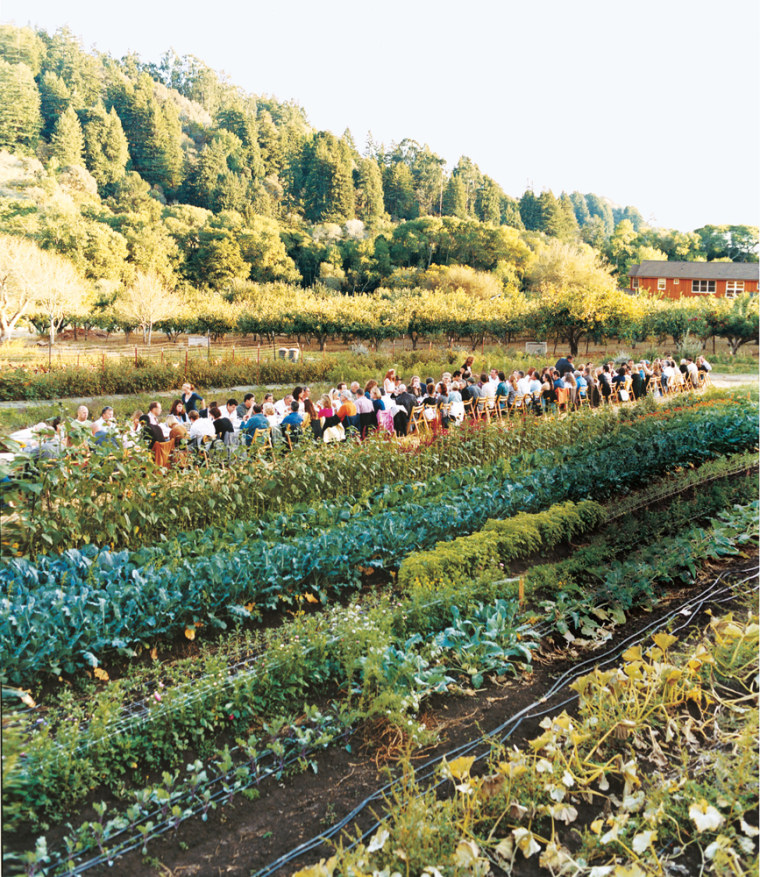
The culinary revolution that began at the end of the last millennium is now turning the spotlight on the farmer — the whiz-bang peasant, the Jeffersonian yeoman, the querulous and cunning plowman who foraged for mushrooms, hand weeded the onion patch, and contrived by means of salt, smoke, yeast, and vinegar to store up a winter's supply of nutritious victuals from the edible roots, flesh, and grapes flourishing outside the door.
I can report from personal experience that the truck patch farmer is enjoying a renaissance. Fourteen years ago, when I began toting my Pennsylvania-grown vegetables to New York City, maître d's would block my passage as I tried to sneak through the dining room during peak hours. Restaurants had not yet discovered how a reputation for seasonal purity might be clinched by having a filthy farmer waltz fifty pounds of just-picked tomatoes between crowded tables and into the kitchen. These days, I sell at a farmers' market, where the chefs are surprisingly lenient when I forget to set aside their heirloom tomatoes. If I were a purveyor (one who buys from farmers and resells to chefs), they'd skin me alive, cut off my ears, and throw them in the soup. They'd run a purveyor's ear soup special until somebody delivered those heirloom tomatoes. But since I'm one of those endangered curmudgeons, they say, "It's OK, farmer. We know you work hard." So it was a rare treat for me this past harvest, as my load of tomatoes dwindled, to take the farmer's equivalent of a busman's holiday, to sit out under the stars and enjoy the fruits of someone else's labor, to dine alfresco while chef and staff toiled in the field.
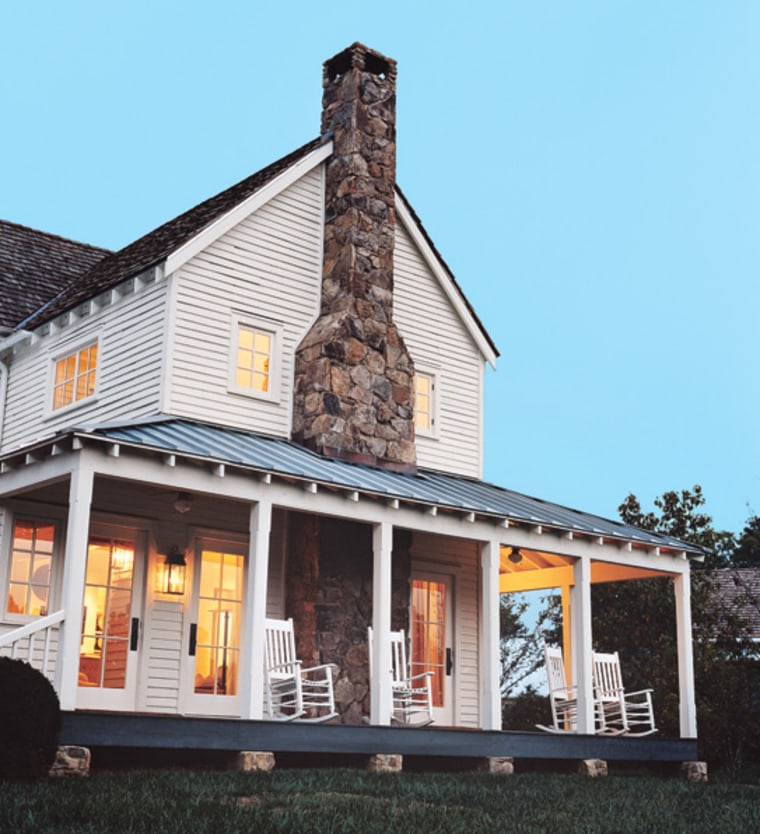
There are yard chickens, too, next to the heirloom garden at Blackberry Farm, in Walland, Tennessee — a garden where I encounter the luminous parsley worm in all her late-summer incarnations: a tawny chrysalis hanging by a thread from the dried flower of a gone-to-seed chive; newly emerged black swallowtail butterflies fluttering among tall, languorous orange-petaled Mexican sunflowers. My favorite stage is the caterpillar herself. Painted with alternating segments of black and yellow, the parsley worm has a bright, chlorophyll-fed greenness that glows in the sunlight like the finest handcrafted Chinese lantern. I can't keep my overcurious fingers from plucking the pillow-soft body from the frond of dill to which she is attached. I raise the parsley worm until we are eye to eye. I growl and squeeze gently. And sure enough, out of the parsley worm's forehead explodes a soft, gelatinous pair of orange horns — a tiny driver's-side airbag installed by nature to burst forth at the sign of danger. Chastened and aghast, I back down as though frightened by this demonic apparition. I return the parsley worm to her feast, and the horns instantly retract.
Beside Blackberry's garden stands a lofty native persimmon tree from which orange golf balls of syrupy essence-of-persimmon drop dead-ripe to the ground — cursed with no shelf life, unless you happen to be seated nearby. My native persimmon is served on slate with a few dabs of Blackberry Farm honey next to a wedge of the farm's signature cheese, a nutty aged pecorino-like delectation made with milk from the East Friesian sheep roaming the hillsides. I savor it by candlelight, as the famous Smoky Mountain fog settles down upon those spooky hollers and a full moon creeps into the mild late-September sky. Above me, bats dive-bomb and trace rickety curlicues of flight in the illuminated night. I am blissfully embedded in my own edible landscape, snug as the bright-green and yellow parsley worm.
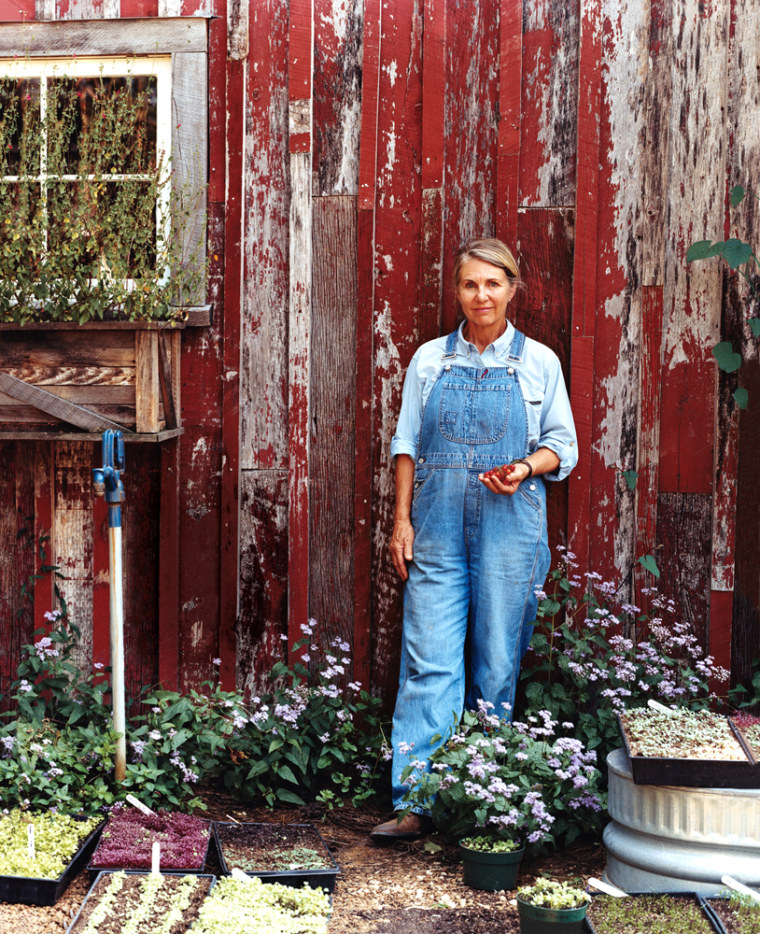
Before the persimmon, I eat a ragout of Washday beans under the same moon—an epicurean collaboration between Blackberry's gardener, John Coykendall, and executive chef Peter Glander. Coykendall sits next to me throughout dinner, which is how I learn the story behind the name of the Washday bean (since it didn't require much cooking time, it was the bean that was cooked on the day Mom had to go down to the river and do the family's laundry). Glander's astonishingly straightforward ragout combines the beans with the white flowers and the tender young "snaps," or beanless pods, from the same plant: the freshness of the garden bean, the sweetness of the flower, the crisp haricot vert — like perfection of the snap.
Elevating the survival victuals of mountain folk to the level of haute cuisine is the cornerstone of Blackberry's "foothills" cooking. I for one do not object to having to settle for the kind of food that got served up when there wasn't time to fuss over dinner. Simplicity can be deceiving. The presence of the commercially unavailable Washday bean in the garden depends on Coykendall's saving seed for it. The bean flowers have to be picked early in the morning — indeed, the chef harvests them himself — because the flowers close up in the sunlight. "I give them a quick soaking," says Glander, "then I cook them in the soaking liquid. That liquid is your gold. The flavor of the bean is in it, the flavor of the soil." Only twenty-eight years old, Glander grew up on a farm in Greencastle, Indiana, where the family garden always had enough room for salad burnet, sweet corn, and beefsteak tomatoes. During the spring break of his senior year in high school, Glander went to Berkeley, California, to audition for a coveted stage at Chez Panisse. Come summer, he was shelling beans in Alice Waters's revolutionary farm-friendly kitchen.
Born and raised in nearby Knoxville, Coykendall remembers going, as a boy, with his grandfather Congressman John Jennings to visit a garden where a hog lot had once stood. The turnips they took home from that fertile garden were steamed and sliced, slathered with butter, salted, peppered — simple as that. "Those were some mighty fine turnips," he recalls. Coykendall is an encyclopedic saver of seeds, a maestro of butter beans (which is what Southerners call dried lima beans). Throughout the day, staff from Blackberry Farm's kitchen pull up at the garden in a golf cart to snip some micro-arugula, to find out where the black Spanish radishes are growing, to ask Coykendall for a butter bean recipe. When he breaks the pods of his Reverend Taylors, the falling beans remind me of snowflakes: No two white, black, and burgundy patterns are alike.
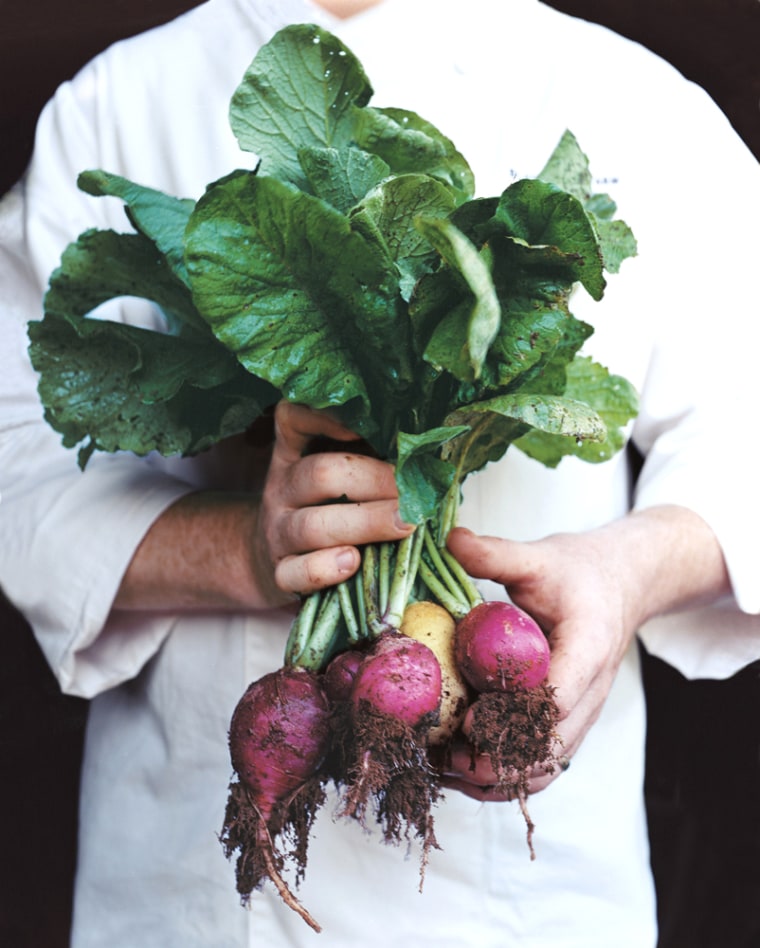
A trip through the garden with Coykendall is a lesson in diversity and preservation. Red Calico butter beans. "These velvet beans are inedible," he says, pulling an attractive black pod from a tall trellised plant. "They were used to feed the cows — made for creamier milk. Here in the garden they're just a 'look piece.' Same with this Mississippi brown cotton. Just a look piece."
Coykendall's whole garden would be a look piece but for a higher calling: the ambitious cuisine dependent upon it, one that reaches for more than Washday beans. Blackberry Farm has positioned itself as a kind of Tanglewood for epicurean adventures. Well-known vintners, cheesemakers, and chefs visit weekly to share their secrets. Just before I was there, Thomas Keller, of the universally celebrated French Laundry and Per Se restaurants, was on-site giving demonstrations. The 2008 lineup of events includes chefs as disparate as Manhattan's pork-obsessed David Chang and Chicago's molecular gastronomist Grant Achatz. Despite the deep reservoirs of quiet to be found on the farm's 4,200 acres, bulldozers and carpenters were at work, too. In a field above the garden, plans were under way to plant chestnut trees and inoculate for truffles. The crown jewel of the farm's multifaceted culinary initiative is the FarmStead, a 14,000-square-foot barn dismantled at an Amish farm in Pennsylvania and reassembled on-site. Inside it, a spacious stainless steel kitchen, a wine cellar, a demonstration kitchen, and an airy dining room were nearing completion. Next to the FarmStead, the larder was also in the final stages of construction: a kitchen for making the farm's sheep's milk cheeses, a charcuterie, a puttin' up pantry. So much depends upon a garden.
If Nathaniel Hawthorne were alive today, I bet he could write a delicious allegory about our present-day relationship to the food we eat. Our forebears did a bang-up job of clearing forests, laying railroad track, and streamlining the productivity of those sprawling fields of grain so we would never have to toil like they did. (Washing their clothes in the river, to boot. And shelling those tedious peas.) Today, American farmers collectively produce five times as much food as they did in 1950. Now that most of us are free to eat whatever we please, the wilderness we find ourselves peering into with puritanical dread is the complex system by which our food slouches from some far-off and faceless farm to our table. With increasing skepticism, we gaze upon labels like "gourmet," "all natural," "organic," and even "artisanal." The "gourmet" market has become so flooded with "artisanally" hand-collected "diver scallops" that half the population of Maine must be saddled with the bends.
"Eat local" has become the mantra for food purists, spawning new categories of peculiarly American diets: the hundred-mile diet, the slow-foods diet, the locavore diet. Buy your food from a producer you know, the argument goes, and not only do you revitalize a community of farmers, butchers, foragers, and cheesemakers; not only do you avoid those industrial foodstuffs known to contribute to obesity, diabetes, and heart disease; not only do you save the carbon emissions that would have been required to transport the same item thousands of miles; but you will find that the peach or tomato tastes better. This last reason was the idea behind Chez Panisse, the restaurant Alice Waters opened in Berkeley in 1971. Waters wanted to serve food that tasted as good as what she had eaten in France. In the ensuing atmosphere of make-it-up-as-we-go-along, the artists, poets, and philosophers who got Chez Panisse off the ground forged a local-food-producing community and sparked the most enduring movement to come out of Berkeley.
If you doubt the permanence of the Chez Panisse–inspired food revolution, you need only go to the other coast and take a look at the restaurant David Rockefeller spent $30 million to launch in a pre-existing Norman-style stone barn on the 3,000-acre Rockefeller estate, just north of New York City in Pocantico Hills, New York. When you pull into the driveway at Blue Hill at Stone Barns, the farm-to-table restaurant orchestrated by former Chez Panisse understudy Dan Barber, the first thing you notice is that chickens are frolicking on some of the most valuable real estate in the country. This delightful incongruence conjured up for me an upbeat sequel to "Fiddler on the Roof," one in which Tevye moves to America, strikes it rich, and follows through on his vow from "If I Were a Rich Man": "I'd fill my yard with chicks and turkeys and geese and ducks / For the town to see and hear."
Dinner at Blue Hill at Stone Barns is a museum-quality ensemble of ingredients from next door's Stone Barns Center for Food and Agriculture. Though my meal was not served outdoors, it might as well have been, so pristine were the just-picked vegetables, which the waitstaff lovingly showed off at the table as though they were rare vintages about to be uncorked. A pinkish-orange Beauregard sweet potato was nearly the size of a football. Celtuce, which tastes like a celery-lettuce cross, gave off the musk of just-out-of-the-field greens. You can't get any fresher than that.
Back at Everett Farm in California, I had talked to Severino, the chef who prepared the family-style feast. "There are two ways to put together a menu," he said. "You can imitate some recipe — throw in truffles, foie gras — or you can limit your choices to what is available. For me, this second method leads to greater creativity. I had ten excellent Hunter Hill wines to pair with and all of those beautiful vegetables. The farmers had some watermelons they didn't know what to do with, which is how I came up with the soup."
Back when Severino was sous-chef at David Kinch's Michelin two-star restaurant Manresa, he started butchering pigs on the side. The process of breaking down a three-hundred-pound carcass and rendering every piece into lip-smacking fare-roasts, pork chops, salami, bacon, testa fredda — had a meditative effect on Severino, especially when compared with the frenetic high-wire act of turning out a hundred perfect meals a night. Before long, his porcine products were so popular he quit his day job. His secret? Pastured, happy, free-roaming hogs raised at Jim Dunlop's TLC Ranch — and technique. Severino's grandfather had butchered pigs back before the band saw made it possible to cut through a hog like it was a loaf of bread. His only tools are a cleaver, a knife, and a handsaw. Breaking down a hog takes five times longer without a band saw, but he gets to use so much more of the pig: the jowls for guanciale, which was layered onto crostini; and the skin and fat, ground up and stuffed into casings to make cotechino, which was braised in wine and combined with Early Girl tomatoes, roasted peppers, and grilled head lettuce for a rich and comforting third course.
The final dish, served as the sun disappeared, was a mesquite-grilled pork belly confit served over kohlrabi sauerkraut, a dish best eaten in the dark, the mouth sinfully agush with luscious melting fat and salt-cured brassica. Positioned at one end of the mile-long table, I kept on eating, my dazzled eyes following the wineglasses that seemed to go on forever into the night, refracting the light of myriad candles, on and on like swirling galaxies, a Milky Way of twinkling stars to commemorate an unforgettable feast.
As a farmer from eastern Pennsylvania, where the ground freezes for three months in winter, I can only drool over the Mediterranean climate with which those latter-day Etruscans are blessed on the northern California coast: dry, moderate coastal summers that yield consistent wines and support olive trees, persimmons, pomegranates, citrus fruit, artichokes. To grow an artichoke in my backyard, you have to start the plant in a greenhouse in January and put it outside in early April, after the bitter cold nights have ended, to fool it into thinking that it is enduring a mild Mediterranean winter. Artichokes will not sprout until the second summer. It's no wonder the hundred-mile diet has so many adherents in the San Francisco Bay Area.
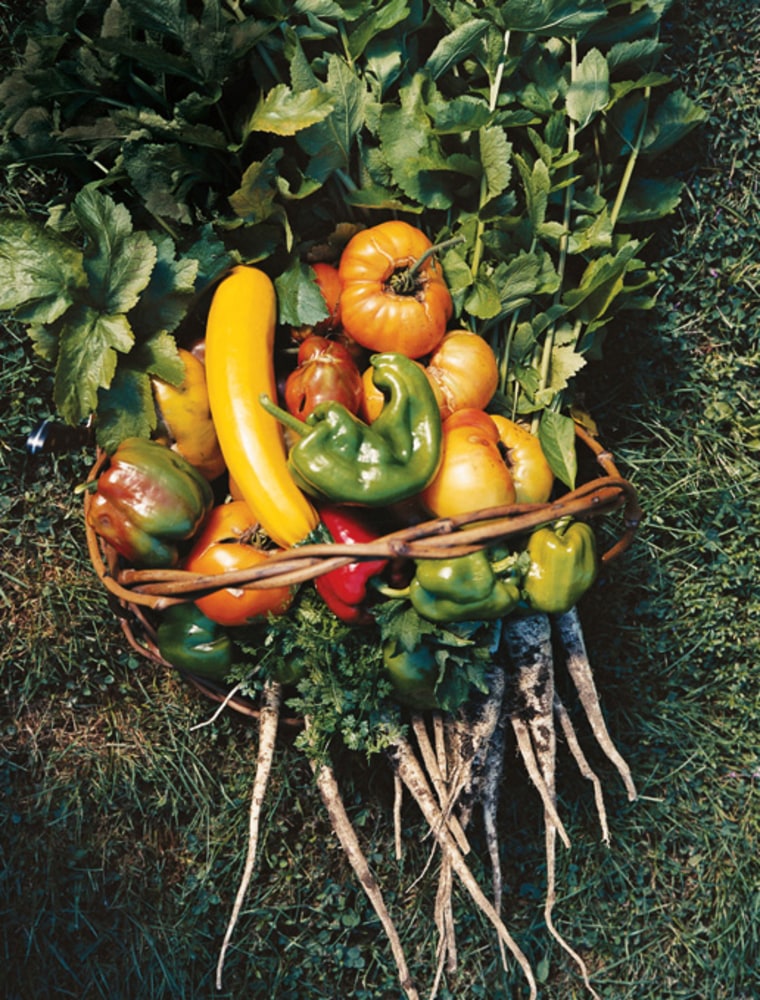
But my winters are nothing like those in Ogunquit, Maine, where I was headed next. Snow was piled halfway up the first-floor windows of the colonial farmhouse and restaurant Arrows when Mark Gaier and Clark Frasier first saw it twenty years ago. The two had flown in from San Francisco — where they had worked at Stars, started by Chez Panisse alum Jeremiah Tower — and were now in the market for a place of their own.
By the grace of all that drifted snow, they couldn't see the pile of work awaiting them, so they took out a one-year lease on the farmhouse, put together an admirable wine collection on a shoestring budget, maxed out their credit cards, and, as Frasier confesses, "washed our fair share of dishes." In 1988, the vegetables available to a Maine restaurant paled in comparison to what the two chefs had been accustomed to in San Francisco. Mesclun salad greens did not exist. Arugula was a ratty half-useless import. You were better off with iceberg lettuce.
Necessity is the mother of invention. They had to clear woods to keep expanding the backyard garden, which doubled in size for the first couple of years. Nearly two decades after their venture was launched, I took a late-summer walk through Arrows' grounds. Rae Avery, the gardener, was picking the last of the slender haricots verts. Striped German tomato plants were dropping their leaves and backsliding into autumn, while a healthy crop of ground cherries, those marble-sized sweet-sour cousins of the tomatillo, were plumping up inside their husks. Lavender, purple basil, lemon thyme, nasturtium, rosemary, calendula, Biergarten sage. Raspberries appeared to be too small to ripen before frost. Bitter fruit of those northern summers!
But the purple and green cabbages eagerly anticipated the first sweet kiss of frost. And inside some two dozen open cold frames, autumn-loving mustard, mizuna, kale, baby bok choy, and arugula geared up for the months ahead, when protective fabric would be pulled over them to keep the restaurant supplied. "In December," says Frasier, "people don't believe the salad grew outside, so we bring them out and show them."
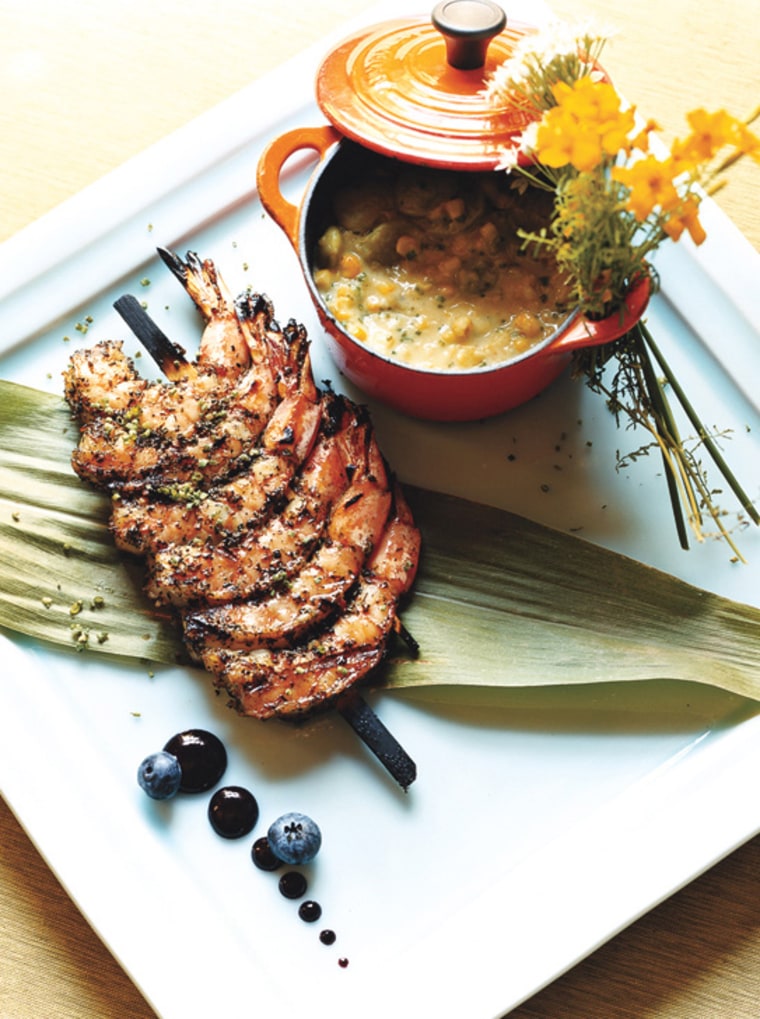
In part because of all of those flowers and herbs, Arrows transformed itself from a rockin' brasserie into a romantic destination restaurant in the mold of the transcendent Michelin-starred French or Italian inn. Huge bouquets of flowers adorn the dining room, where once a week on average a marriage is proposed. As would be expected so far north, Arrows depends on old-fashioned methods of preservation: house-cured sausages, duck pastrami, and of course prosciutto. In the brick smoker built onto the side of the restaurant, both cold and hot chambers are used to smoke salmon and trout.
But preservation works on many levels, as Coykendall reminded me at Blackberry Farm. Among the heirloom vegetables served to me at Arrows were two of my favorite lettuces — satiny Deer Tongue and sweet Berggarten, or freckled romaine. Cherokee Purple and Brandywine tomatoes. The recently revived lemon cucumber. Thin Oriental eggplant. The tangy apple tart could only have come from the gnarled apples that fell from the wild, once neglected apple trees by the garden.
But it was succotash — a truly regional dish that retains its Native American name — which blew me away. "The limas in the succotash came from the garden of a former dishwasher," our server admitted. "Not enough room in our garden." I was reminded of stories I'd heard about Chez Panisse in the early days, how lettuces were supplied by the backyard gardens of Berkeley friends. Until recently, lima beans were a mealy, unanimously despised freezer item that found its way onto the table whether or not it was wash day. Succotash was the tricolored mishmash occupying the smallest dent in the aluminum TV dinner tray. But these limas were done perfectly-crisp, the essence of beaniness, the heart and soul of succotash.
Like corn and tomatoes, limas were discovered in the New World, our world, the world we are just rediscovering.
